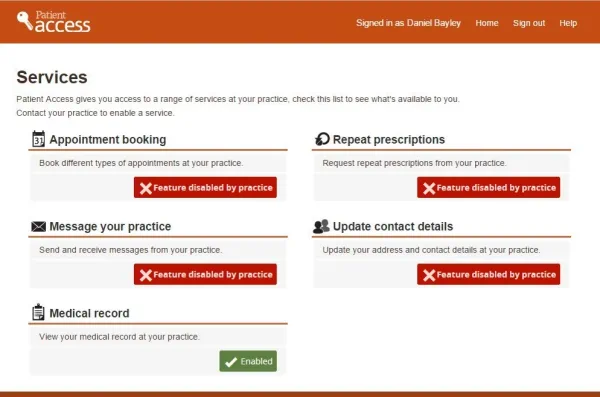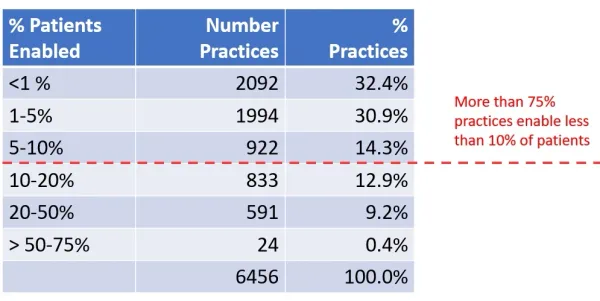The problem with Patient Online and the NHS App
Published : Sunday 16 June 2019
We are likely many many years away from universal and equitable access to NHS health records despite the technology existing today ...

Please note: this content is 6 years old. It may be of lower quality or no longer accurate.
Patient record access has long been talked about in the NHS but the delivery has been fragmented at best, despite £billions invested in IT, various contracts, patients legal right of access, not to mention all the announcements and fanfares.
In 2015 the updated GP contracts set out various requirements to provide patients with online access. Alongside this, the various software vendors were required to make the technical capabilities for online services available to GPs.
From April of 2014 GPs were required to offer patients to view their record online including. medications, allergies and adverse reactions and any additional information the patient requested. The latter point is an important one which we’ll come back to.
From the GP contract negotiations in 2015, GPs were also required to offer online access to detailed information in patient records. /NHS-patient-access-online.webp
Not all systems supported these features from the outset but all GPs were required to at least publish their plan for how they would implement the necessary local changes with a view to meeting the requirement by 31 March 2016.
Since 2016 the technical capabilities have been broadly available to GPs to enable the ordering of prescriptions and booking of appointments as well as providing access to health records including core record information, results and letters/documents.

(Click for full resolution)
Over 3 years after all this has happened much of the problem has then become the ability and willingness of GP practices to enable patient record access and if they did, what information they chose to make available.
Despite patients having legal rights to their record as far back as the Data Protection Act 1998 many organisations continue to create records assuming patient access is the exception rather than the norm. This means that organisations need to review records before releasing them thus creating a rod for their own backs.
The Data Protection Act was updated in May of 2018 to further enhance the rights of patients but in general, this has not moved the needle from a patients perspective and indeed not much appears to have changed in terms of how organisations manage, create and release records to patients.
New contracts and the NHS App
Recently Matt Hancock (Secretary of State for Health and Social Care) and the NHS more widely have been trumpeting the next generation of IT contracts as well as the NHS App, with the patient record access fanfare once again being played.
The problem is that no amount of new standards, technology and contracts will improve the situation for patients if the gatekeepers to patient records continue to deny them access and create records in a manner which makes it hard for patients to readily access them without intervention.
It seems without a significant policy and contractual shift which is properly enforced, little is going to change. Perhaps the solution lies in regulation as we have seen in the US where “Meaningful Use”, a term used to define minimum U.S. government standards for electronic health records, has defined how information must be shared in particular between healthcare providers and patients, with financial incentives/penalties.
However, no matter how fast this all moves, baring in mind there is a 10 year plan, we are likely many many years away from universal and equitable access to health records despite the technology existing today. Not to mention that much of the conversaiotn has focused on GP records when what many patients really need is access to their hospital records.
So what’s the answer?
There are pockets of good practice with one notable example being Haughton Thornley Medical Centres in Hyde which was formerly run by the infamous Dr Harold Shipman. This practice has over 60% adoption of record access whereas most fall well below 10% and many barely getting off 0%.
This one good practice is certainly the exception rather than the rule and with the NHS historically struggling to share and adopt good practice, GP services remain highly variable to say nothing of NHS hospitals which have problems of their own.
Indeed where detailed access is reportedly enabled, the level of access is highly variable and so the reality for patients is much worse than the figures present.

(Click for full resolution)
- Percentage of patients enabled with “detailed access” - Source NHS Digital
The good news is that legally individuals have a right to their record, regardless of the problems local organisations may have with making this available. Patients with a desire to gain access to their record can exercise their “Right of Access” to obtain a copy of their record and indeed much of this can be made available by the existing online portals.
As mentioned earlier the GP contracts make reference to this point in that GPs were required to offer patients the ability to view their record online including “any additional information the patient requested”.
As such by exercising your Right of Access you can request that your GP makes more information available online. Where practices are unwilling or unable to do this you are still entitled to an electronic copy. The same applies to hospitals or indeed any organisations which holds information about you.
Certainly, in the short term, this provides patients with a means to press the health service to release information, and growing demand from patients may start to change mindsets.
Taking the Right of Access approach is not without its challenges, as many organisations do not understand the basics of NHS policy let alone Data Protection law. Indeed there are many who still believe that basic technology such as email cannot be used for communicating with patients.
In previous blogs, I have shared my own personal experiences as well as shared some general tips and pointers on using the data protection act to access your record.
Conclusion
The conversation about patient record access has been something of a circular debate with various “leaders” in healthcare getting up and talking about the same issues every few years, but struggling to move things forward in a way that has any appreciable impact or benefit for patients.
The technical and legal means exist today and what we need is a change in attitudes and cultures to drive this forward, but perhaps the patients can bring about this change by exercising their rights and putting more pressure on healthcare.
Patients certainly have the opportunity to take the lead and by working through local patient groups there is the opportunity to change the tempo by helping to educate patients and professionals alike.
Alongside this patients and patient groups need to lobby their local MPs as well as Information Commissioner’s Office (ICO) and National Data Guardian (NDG) who preside over the regulations and policies governing healthcare, to put pressure on healthcare to bring about the necessary changes and quickly.
Useful links and references
- NHS Health Record Access Tips
http://blog.danielbayley.co.uk/2019/06/nhs-health-record-access-tips.html - BMA Guide to GP Contacts and patient record access.
https://www.bma.org.uk/advice/employment/contracts/general-practice-funding/gp-contract-2015-2016-england/gp-contract-it-requirements - ICO - Your right of Access
https://ico.org.uk/your-data-matters/your-right-of-access/ - ICO - Right of Access guide for organisations.
https://ico.org.uk/for-organisations/guide-to-data-protection/guide-to-the-general-data-protection-regulation-gdpr/individual-rights/right-of-access/ - The National Data Guardian
https://www.gov.uk/government/organisations/national-data-guardian
Dan's Blog
Information Technology, programming, health, fitness and photography enthusiast.
- Not a writer.
- All views are my own.
- Offence is optional.
- Do your own research.